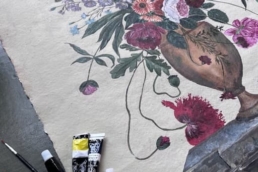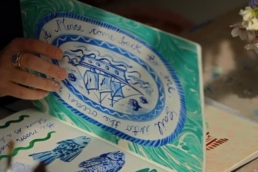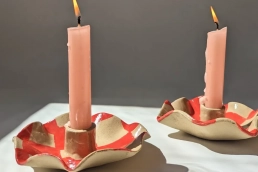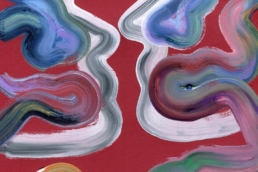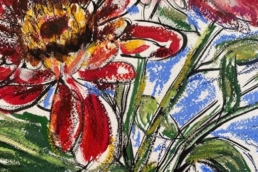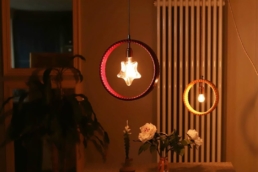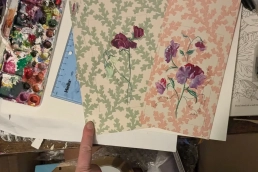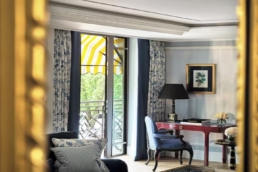We recently connected with David Perry, whose vibrant glass creations are characterised by meticulous precision and bold, geometric patterns. David shares his fascinating journey from an IT career to embracing a creative life in Cornwall, where the coastal surroundings inspire his dynamic glasswork. He delves into his passion for the science and artistry behind fused glass, the joy he finds in perfecting each hand-cut square, and how continuous learning and environmental consciousness drive his evolving practice.

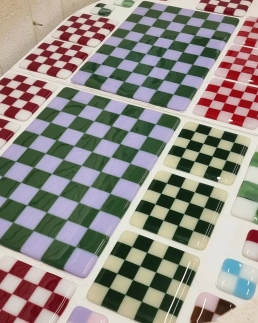
1. Can you tell us a bit about yourself and your artistic journey?
I was born in Mitcheldean and lived in Gloucestershire, starting my career making spectacles in a factory, moving onto pensions, and then I.T. for over 15 years. I moved to Cornwall in 2011 and although I initially continued working in IT, living by the sea and adapting to the Cornish way of life had a big impact on me. I wanted to explore life in a more creative way including scuba diving and photography. In 2017 I took the plunge and became self-employed with my photography and fused glass, also tinkering with ceramics. Although my artistic journey started a little later in life, I have embraced it and have grown as a person as well as in my art. In 2022 I went one step further and became a part-time life drawing model and encourage others in their artistic journey.
2. What inspired you to pursue your craft? Was there a defining moment or influence that sparked your passion?
I attended a local fused glass workshop and was hooked, I really wanted to learn more about the science behind fused glass and to see how far I could use the materials to push my creative boundaries. I gave myself two years to see if I could start making an income from my art and knowledge; it is now 2025 and I still feel the excitement of working with glass and knowing that my art is enjoyed in homes all over the world.
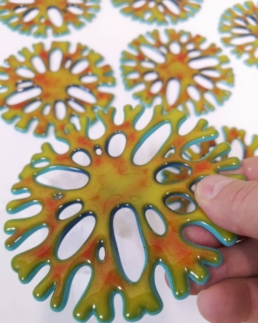
Your craft
3. How would you describe your work in three words?
Chequers, precision, colourful
4. What materials or techniques do you use, and why are they important to your process?
Chequered patterns are my best-selling products, and I take great pride in meticulously hand-cutting each piece of glass to ensure they are as perfectly square as possible. This precision of the crisp lines allows the pieces to fit seamlessly together in the kiln, creating the signature look I love to see in my pieces.
5. Can you tell us about a favourite piece you’ve created and the story behind it?
I really enjoy working with glass powders (instead of the normal flat glass sheets I use for most items), as the powders blend and can be layered to create unique pieces like my crackle bowls and coral style vase.
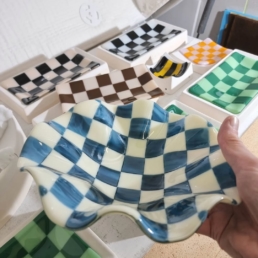

Creative process
6. What does a typical day in your studio or workshop look like?
Squares, squares and more squares! Did I mention squares!? After planning what needs to be made and fits in the kiln space, the next task is hand cutting hundreds of squares, stacking them in piles so I know which ones will go where and then hand cleaning each one as they are placed on top of a clear glass base inside the kiln. The squares are then carefully nudged around to get them as square and linear as possible.
7. Do you have any unique rituals or habits that help you stay creative?
I really had to think about this question… glass can be manipulated in so many ways that I feel I have barely scratched the surface. I am always learning and have several books and tutorials that I am studying to tantalise my creative taste buds. Speaking of taste buds, I do love a cup of TeaPigs tea while I am in the workshop.
8. How do you handle creative blocks? Do you have any strategies or tips for overcoming them?
Living next to the Cornish coast means I am only a short drive away from walking on the clifftops or beaches or going to woodland to photography nature. If time is a little tight it is time to put the kettle on and have a cup of tea, giving me time to reflect. My I.T. background also means I find website redesigning a refreshing change or using my skills to edit product photography.
Challenges and successes
9. What’s the biggest challenge you’ve faced as a maker, and how did you overcome it?
My biggest challenge is trying to maintain social media and their algorithms daily. Instagram is my favourite media to keep viewers updated, but I have learnt that trying to post several times a day across multiple platforms is just not achievable. Just do what you can as and when you are able to.
10. What’s been your proudest moment or achievement so far?
Being interviewed on Channel 4 TV “Stephs Packed Lunch” back in 2021 surrounded by my glasswork. It was a very nerve-racking experience knowing that thousands of UK viewers watched at lunchtime, but I absolutely loved such a brilliant experience, and I will never forget it.
11. What’s your favourite quote you’ve ever heard about your work? Who said it, or what was the name of the publication?
#Obsessed
- The most popular word from my amazing followers on Instagram.
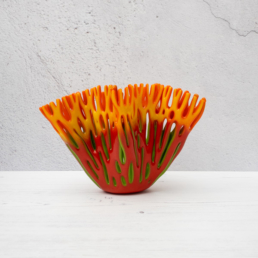
Inspiration
12. Where do you draw inspiration from for your work? What sparks your imagination and creativity?
I have always found geometry and linear lines intriguing; I like the clean and contrasting effect it creates. Chequers or checks are a timeless pattern, but science also plays a part as not all colour combinations and glass types are compatible.
13. Do you have a favourite artist, maker, movement, or tradition that has influenced your craft?
Checkers is everywhere from game boards, fashion, art and architecture to motor racing, so there is whole range of traditions throughout history from the very first checkered floor to the first chess board that have influenced me. Artists who have inspired me include Bob Leatherbarrow, Glenda Kronke, and Marguerite Beneke; all artists who have shared their knowledge and continue to influence my work.
14. How does colour influence your practice; is it an important part of your process? Do you have a particular palette or favourites? Any go-to sources for colour inspiration?
I live a rainbow of colour every day and I do enjoy creating a new combination. Some glass can contain metals which can react with other colours, so science also plays a part in creating the palettes I use. I find inspiration in nature and the many hues you see on the cliffs around Cornwall, and from my social media followers and their suggestions.
Perspectives and goals
15. What role does your environment play in shaping your creativity?
I hand built my workspace at home, so have the shortest commute in the mornings. As soon as I step into my workshop and am surrounded by glass sheets and powders, and put my music on, I feel inspired.
16. What do you want people to feel when they experience your work?
I want my work to make people smile and leave a lasting impression. In a world where we do not always have space for art in our homes, I feel I cross the barrier of creating art pieces that are also practical and will last a lifetime.
17. What are you currently working on, and what excites you most about it?
All things glass fascinates me, so in 2025 I am learning lampworking to create glass sculptures. I am conscious of the environment when I work and ideally, I will use the leftover glass I already have to do this. This will open new avenues for me as the designs you can make are endless. I have 3 very large books to read through first, so watch this space.
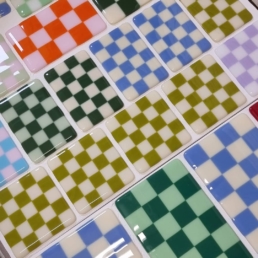
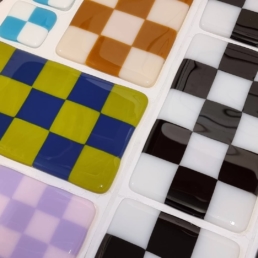
Advice and reflection
18. What advice would you give to someone starting out as a maker?
Starting your own craft business for the first time can be very daunting. I would say to always believe in your products, enjoy the journey of creating as much as the selling. Plan your days to keep yourself focused and get in touch with other creatives for support and advice. Keep yourself visible online or in your local area, depending on where you are focusing your sales. It is an exciting and rewarding journey.
19. If you could go back to the start of your career, what advice would you give your younger self?
Having a creative outlet is so rewarding, start now and believe in yourself.
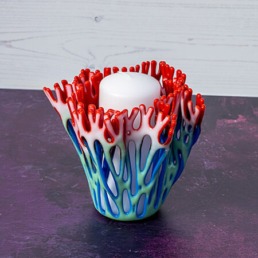
Closing thoughts
20. If you could collaborate with any artist, past or present, who would it be and why?
I think it would be glass artist Bob Leatherbarrow who creates some amazing artwork from sheet glass/glass powders but also produced some very detailed books/videos explaining about how and why glass acts in certain ways from heating, melting, cooling, annealing. He has taught me a lot and inspired me when I started out and continues to do so today.
21. Where can people find your work, and how can they support you?
All of my items for sale are listed on my website davidperryglassceramics.uk and always lots of photos on my socials including Instagram, TikTok and also BlueSky, but the easiest way to find all my socials is via linktr.ee/davidperryuk
David Perry’s glass art brings precision, vibrant colour, and joyful design into everyday spaces. Each handcrafted piece balances practicality with artistic beauty, creating functional artworks designed to uplift homes and captivate imaginations.
Explore David’s latest collections and follow his creative journey:
Support David by visiting his website, engaging with him on social media, and discovering the colourful world of his striking glass art.


